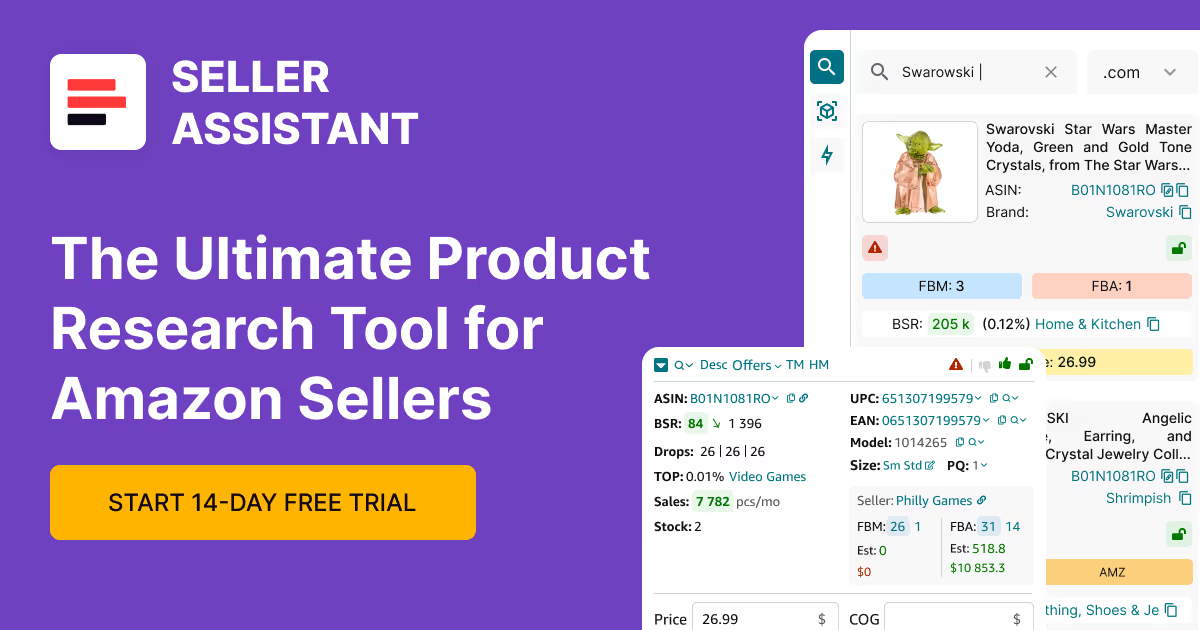Amazon Seasonal Product Check - Complete Guide
Download Amazon Seller Guide
This guide will help you get started, understand the basics of Amazon selling, and explain in simple words how it all works.

As an Amazon seller, understanding the seasonality of products is crucial to stay ahead of the competition and to optimize your sales. By identifying seasonal trends and knowing when to sell certain products, you can take advantage of the ebb and flow of consumer demand throughout the year.
In this post, we'll discuss how to check the seasonality of Amazon products, so you can make informed decisions and maximize your profits. Whether you're a new seller or a seasoned veteran, this guide will provide you with valuable insights into product seasonality on Amazon.
What Is a Seasonal Product?
A seasonal Amazon product is an item that experiences fluctuations in demand throughout the year, typically based on specific seasons, holidays, or events. For example, winter coats and gloves tend to sell more during the cold months, while swimsuits and beach gear are more prevalent during the summer.
Understanding the seasonality of a product is crucial for Amazon sellers, as it allows them to adjust their inventory levels and marketing strategies accordingly. By capitalizing on seasonal trends, sellers can maximize their profits and stay ahead of the competition.
Tip: One situation where this rule may not apply is when selling seasonal Amazon products internationally. In such cases, if a product is out of season in one hemisphere, there may still be opportunities for sales in the other hemisphere. That presents a unique advantage for Amazon sellers, as they can tap into different markets and extend the lifespan of their seasonal products.
Related: Seller Assistant App Extension Review
Seller Assistant App — the Ultimate Tool for Amazon Online Arbitrage

Examples of Seasonal Products
Seasonal Amazon products can be categorized into several types applied to specific seasons, holidays, and events. By understanding the seasonality of these products, Amazon sellers can adjust their inventory levels and pricing strategies to maximize their sales and profits. Below you can find examples of each type.
Seasonal Products:
- Winter coats;
- Summer dresses;
- Fall boots;
- Spring gardening tools;
- Christmas trees.
Holiday Products:
- Halloween costumes;
- Thanksgiving decorations;
- Valentine's Day gifts;
- Easter baskets;
- Fourth of July party supplies.
Event Products:
- Graduation gifts;
- Wedding favors;
- Baby shower decorations;
- Back-to-school supplies;
- Super Bowl party essentials.
By understanding the seasonality of these products, Amazon sellers can adjust their inventory levels and pricing strategies to maximize their sales and profits.
Why Does Seasonality Matter?
If a product is seasonal, it can have both positive and negative effects on Amazon sales for a seller.
On the positive side, if a seller offers a seasonal product in high demand during a specific time of the year, they may experience a significant increase in sales during that period. For example, if a seller sells Christmas decorations, they can expect to see a surge in sales during the holiday season.
On the negative side, if a seller offers a seasonal product that is not in demand during certain times of the year, they may experience a decrease in sales or even have difficulty selling the product at all. For example, if a seller offers winter clothing in the summer months, they may struggle to sell the product as customers are not actively looking for winter clothing during that time.
To mitigate the adverse effects of selling a seasonal product, sellers can consider diversifying their product offerings or finding other products that generate sales during off-season periods.
Related: How to find Profitable Products for Amazon Online Arbitrage
How to Check if an Amazon Product Is Seasonal?
You can see if a product is seasonal by looking at its sales rank history, indicating trends and patterns in consumer demand. Seller Assistant App shows you the sales rank graph that can help you understand whether an Amazon product is seasonal by showing fluctuations in its sales rank over time.
Suppose a product consistently experiences spikes in sales rank during certain times of the year, such as during the holiday season or a particular event. In that case, it may indicate that the product is seasonal. For example, if you are selling Halloween costumes, you may see a significant increase in sales rank in September and October and a drop in sales rank during other months. This pattern suggests that the product has a seasonal demand.


In addition, if a product’s sales rank goes down to zero during specific time periods, that may indicate a seasonal product. Suppose the graph shows that the sales rank goes down to zero in the high season, and after seasonal sales start to increase, that may indicate a seasonal product. On the other hand, if a product's sales rank remains relatively stable throughout the year, it may indicate that the product is not seasonal and has a consistent demand.
Tips to Deal with Amazon Seasonal Inventory
Managing seasonal inventory can be challenging for Amazon sellers, but there are several strategies you can use to deal with it. By implementing these strategies, you can effectively manage your seasonal inventory on Amazon and ensure that you have the right products in stock when your customers need them.
Plan ahead: Before the season starts, analyze your sales data from the previous year to forecast the demand for your products. Use this information to plan your inventory levels accordingly.
Use Amazon inventory management tools: Amazon offers several tools to help you manage your inventory, including the Inventory Performance Index (IPI), which measures your inventory health and provides recommendations to improve it. Use these tools to monitor your inventory levels and make informed decisions about restocking.
Set up automatic reorder points: To avoid running out of stock, set up automatic reorder points based on your sales history and demand forecasts. That ensures you always have enough inventory to meet customer demand.
Consider using Fulfillment by Amazon: FBA can help you manage your seasonal inventory more efficiently by storing and shipping your products for you. That allows you to focus on other aspects of your business, such as marketing and customer service.
Offer promotions and discounts: To stimulate sales during the slow season, consider offering promotions and discounts to encourage customers to buy your products. That can help you move excess inventory and improve your cash flow.
Make use of off-season sales: You can benefit from off-season sales when stores often provide discounts for seasonal items that are not in demand. Utilizing these sales can result in cost savings and minimize the need to purchase a large inventory during peak seasons.
Tip. To manage your inventory effectively, we recommend using SoStocked. SoStocked is an incredibly versatile Amazon inventory management and forecasting software solution that incorporates an innovative forecast algorithm. This cutting-edge tool addresses various challenges faced by sellers when it comes to inventory management on Amazon. By utilizing SoStocked, you gain full control over critical aspects such as over-ordering, under-ordering, delayed ordering and transfers, order and payment tracking, spreadsheet management, bundle management, purchase order follow-ups, multiple marketplaces, and the prevention of expensive warehouse recounts.
Related: Amazon Inventory Management
How Does Amazon FBA Work. Is Amazon FBA Worth It?
Final Thoughts
Understanding the product seasonality is crucial for any Amazon seller looking to maximize their sales potential. By utilizing the seller tools, you can identify patterns in consumer demand and adjust your inventory accordingly. Additionally, keeping an eye on external factors such as holidays and events can give you a competitive edge and help you stay ahead of the curve. Remember also to consider any trends or changes in the market that may impact your product's popularity.
Take the time to check the seasonality of your products and adapt your strategy accordingly - your bottom line will thank you for it. Seller Assistant Аpp will effectively and reliably help you with this task. Seller Assistant App is a comprehensive extension that encompasses essential features for product research. With this all-in-one tool, you can effortlessly access crucial information such as a product's profit, margin, and ROI. Additionally, it enables you to quickly identify any sales restrictions or previous issues that might have affected your account health. It combines an FBM&FBA profit calculator, Quick View, Stock Checker, and Restrictions Checker in one tool.

.svg)













